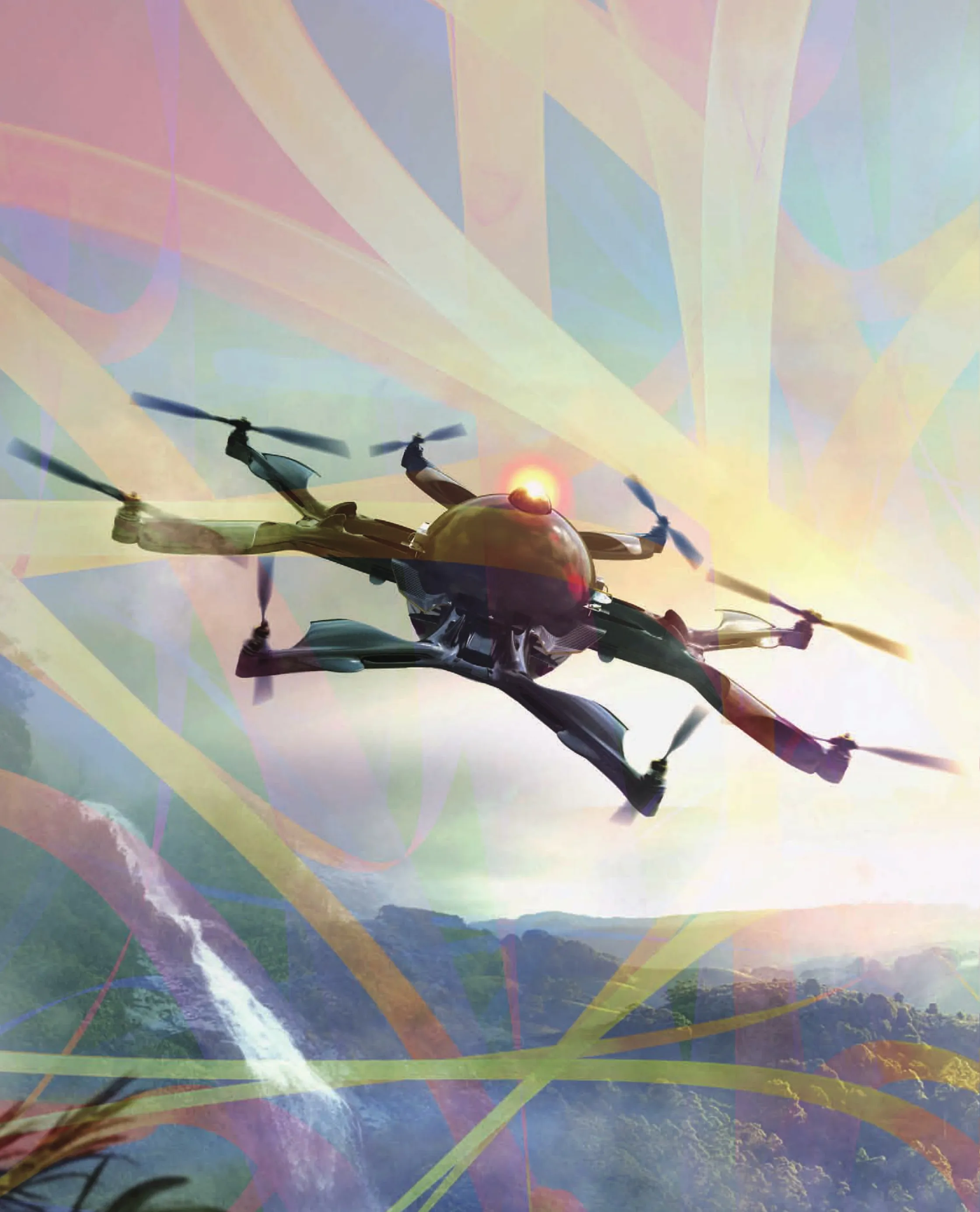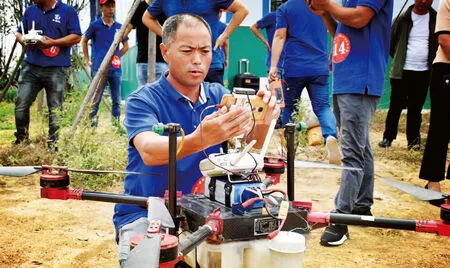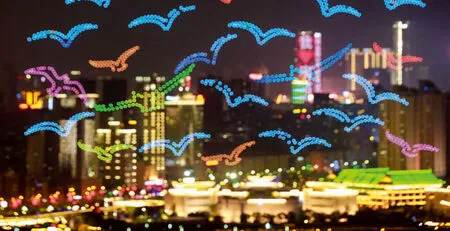GAME OF DRONES
BY TINA XU (徐盈盈)

China’s fast-rising drone market is changing the landscape of innovation, law enforcement,and entertainment
中国崛起的无人机市场正在改变着创新、执法和娱乐的图景
Homing in on a piece of blue steel jutting out from a rocky cliff, the drone camera zoomed to capture signs of human activity and household garbage scattered on the slope. It had finally found the fugitive’s hiding place.
In the densely forested hills of Yunnan province, local police had searched for the notorious human trafficker Song Jiang for 17 years. Last September, equipped with a squadron of drones, authorities scoured the rugged landscape and finally found Song’s remote cave dwelling from above, and put him back behind bars.
Versatile, efficient, and often relatively low-cost, unmanned aerial vehicles (UAVs)—commonly known as drones—form a 22.5 billion USD global industry, projected to nearly double to 42.8 billion USD by 2025.The integration of drones into society continues to expand the ability of groups as diverse as police, civilians,farmers, environmental watchdogs,and military to search, detect,monitor, and survey—changing the way humans plant crops, put out fires,enforce the law, and fight wars.
“As the drone lifted off the ground,I instantly understood what people meant when they said you can see the world from a different angle,” wrote a hobbyist named Ergo Li in a thread on question-and-answer platform Zhihu, recounting his first drone flight. “It was like a god’s eye view.”
While drones have become widely popular among gadget-lovers for taking birds-eye view photos or experiencing the thrill of flight, the devices are undergoing “a revolution from ‘playful’ to ‘useful,’” says Gao Xidong, marketing director of Beijing WeLion New Energy Technology,a drone battery manufacturer.UAVs are increasingly sent where it is dangerous for humans to go:across rough terrain, into radioactive substances, up to high cell towers,and, in times of pandemic, into crowds.
“Auntie, we are speaking to you,” a loudspeaker affixed to a drone boomed at an elderly woman walking in her village in Inner Mongolia, in a video that went viral in January. “Don’t walk around without a mask. Go home!”fussed the voice, as the woman scurried off. “And wash your hands!”
In the first days of the Covid-19 outbreak in Wuhan, Chinese drone manufacturer Antwork’s RA3 and tr7s drones were used to carry patient samples from Xinchang People’s Hospital to the disease control center,cutting transport times by half without exposing delivery workers to potential infection. An army of drones were mobilized to spray disinfectant in Jilin,Shandong, and Zhejiang provinces,with one villager’s pesticide-spraying drone repurposed to disinfect an area of 16,000 square meters in one morning.

Drone training programs and competitions are now common as China seeks to license 100,000 industrial drone operators
Manufacturers are also developing drones to go where existing machinery is inefficient: The majority of Chinese farms consist of small-scale plots,with staple crops such as rice paddies located on muddy hillsides unsuitable for heavy machinery like tractors.
Hovering above a terraced field, the newly announced JetSeed by Chinese drone manufacturer XAG shows remarkable agility as it shoots seeds into silt at even depths and distances,claiming to equal the speed and efficiency of 50 laborers.
“Development of UAVs carries the potential birth of a new industrial revolution, with irreplaceable uses in many fields, from emergency response to fire fighting,” said Shan Guangcun,an AI researcher at Beihang University, the country’s premier aeronautics institute, on a panel at the Global Conference on UAV application in Beijing in October.“We welcome the arrival of the smart future.”
A team at Beihang was behind the first UAV flight in China, which took off from Beijing Capital Airport in 1959. In 1962, Beihang opened China’s first UAV research center.Since then, the seemingly endless potential for application has kept drone researchers busy, while making the technology a key part of the central government’s industrial development strategy and ambitions for global technological dominance.

Chinese companies design and manufacture over 70 percent of the world’s civilian drones
UAVs were named a priority industry in the National 13th Five-Year Plan from 2016 to 2020, with the government subsidizing the adoption of agricultural drones in target pilot provinces. UAVs were also declared a strategic industry in the State Council’s 2017 “New Generation Arti ficial Intelligence Plan,” which seeks to make China a world leader in AI by 2030,and provides generous funding for related research and development.
The Chinese UAV market, which manufactured 2.9 million drones for an output of 13.6 billion RMB in 2017, is expected to increase eight-fold by 2025.China is already the world’s largest manufacturer and second largest market for civilian drones, selling 70 to 80 percent of drones on the global market.The vast majority of this growth was driven by global drone behemoth Da-Jiang Innovations, or DJI.
Its founder is Hangzhou native Wang Tao, also known as Frank Wang, who assembled the first DJI prototype in his dorm room at the Hong Kong University of Science and Technology,before moving to Shenzhen to start the company in 2006. Allegedly, Wang required all job candidates to solder drone parts together by hand, even for positions in marketing and human resources. Re fining the technology behind speed controls, motors, and radio modules, his team successfully flew an unmanned chopper around Qomolangma, or Mount Everest, in 2009.
In a little over a decade, DJI’s drone empire has gone global, edging out US competitors like GoPro,which withdrew from the drone market in 2018; and 3D Robotics,which now designs software for DJI drones instead of making its own.Wang became Asia’s youngest tech billionaire, and the world’s first drone billionaire in 2017.
Heartened by DJI’s astronomical rise, and encouraged by the government’s push for technological progress, China’s burgeoning UAV industry has heated up, with 1,200 drone start-ups popping up in Shenzhen, Guangzhou, Chengdu,and other cities.
Part of the reason why Chinese drones have developed so quickly, claims the drone battery manufacturer Gao, is ready access to electronics factories, as well as fewer domestic regulations on licensing and intellectual property. “American drones spend years in feasibility studies and die in them,” says Gao.“We are all rushing forward like a swarm of bees.”
However, Gao notes that the majority of drone start-ups like his are not yet pro fitable, and estimates that a third of Chinese drone companies have gone bankrupt in the last year.“[Tesla CEO] Elon Musk recently said that innovation is like swallowing glass. Over 90 percent of us will likely die,” Gao lamented to TWOC.“How much talent and money did China invest into the growth of this industry? We are using the blood of one thousand drone companies to exchange for our tomorrow.”
But among those who seek a safe and effective way to replace human labor, the sales of industrial drones are now growing far faster than that of military and consumer drones. In 2019, the global market for industrial drones was valued at 4.8 billion USD,a 30.7 percent increase from the year before.

An agricultural drone sprays pesticide over a field in Xinjiang
Governments are some of the most eager adopters of drone technology,buying 40 percent of industrial drones globally, according to consulting firm BlueWeave. Of these, 26 percent are used for fire fighting, 17 percent for agriculture, 10 percent for energy surveys, and 6 percent for geographical surveys.
While police drones have not yet entered the official budget of the Chinese Ministry of Public Security,individual police departments are beginning to experiment with the technology, said Ji Renxin, director of China Fire and Rescue Institute, at October’s conference.
Shanghai, for example, has partnered with Beihang and other institutes to examine how drones could help the city respond to a leak from any of 54 nuclear plants in eight provinces along China’s coastline in an event like Japan’s Fukushima Disaster in 2011, in which 300,000 people were evacuated due to radiation.
With current technology, it takes too long to take radioactivity samples and process them in a lab in an emergency situation, according to researcher Shan. A drone could enter high radiation zones along the coast and drop floating monitoring devices into the water, forming a radiation monitoring network to direct emergency response in real-time.
“The utility of drones in emergency rescue is very clear, but the technical requirements are complex,” Shan explained at October’s conference.For now, drones primarily provide monitoring and drop-off, such as Beijing-based company ZHZ’s new“Big Yellow Bee” (TD5), which can be equipped with high pressure hoses and fire-extinguisher bombs.
With further advances in technology,fire fighting drones could plausibly become highly heat-resistant, waterresistant, able to maintain signal through thick smoke, fly through strong winds, and hover for hours without overheating.
However, as Chinese drones glide into global markets, they have met the capricious winds of international politics. Last May, just after the US Trump administration moved to ban Shenzhen-based telecommunications firm Huawei from doing business with US companies, calling it “an arm of the Chinese Communist Party’s surveillance state,” the US Department of Homeland Security followed with a warning about Chinese drone technology.
This caused chaos for the US federal agencies and more than 900 local and state law enforcement and emergency service agencies that have stocked DJI drones. The US military ceased use of Chinese drones in 2017, and this January, the US Department of the Interior grounded its fleet of over 800 DJI non-emergency drones, leaving teams shorthanded to prevent forest fires this summer. Currently, the US Congress is debating a bill to ban the purchase of Chinese-made drones with federal funds.
Technology is never disentangled from politics. China has become one of a handful of countries that can create strike-capable military drones.Its Caihong CH-5 is comparable to the US Reaper. While the US only sells drones to its close allies, China sells openly, putting military drones into the arsenals of countries as far-ranging as Pakistan, Saudi Arabia, UAE, Iraq,Turkmenistan, Algeria, and Serbia.
Yet while American drone strikes have killed an estimated 2,500 militants and civilians in Pakistan, Afghanistan,Yemen, and Somalia, China’s drone force has yet to make a single deadly strike.
In China, local governments eagerly adopt drones into their surveillance programs, joining an estimated 170 million surveillance cameras across the country. In 2017, DJI announced a partnership with Xinjiang’s public security department to support“stability maintenance” and “counterterrorism.”
Even as “eyes in the sky” may provide for ever-wider spheres of government surveillance, drone technology also allows civilians to serve as watchdogs.
When the Suzhou-based NGO Green Jiangnan Public Environment Concern Center received complaints from villagers in Anhui province that their crops were dying due to water pollution from nearby chemical plants,they went to investigate.
“Before, if you try to go inside the factory, the employees will catch you and stop you. If it’s a photo, they might even say you faked it,” Lu Li,a program officer at Green Jiangnan,tells TWOC. “Now, with a drone, you can fly to 500 meters high and take a video. There’s not much they can say.”As drones become ubiquitous in the hands of civilians, government, and industry, China aims to train 100,000 licensed industrial drone fliers. Dai Yuqiu, a 19-year-old student at North China Institute of Science and Technology in Hebei province, hopes to be one of them.
In sparkling eyeshadow and a school uniform, Dai represented her school at a youth drone competition this October that tests students not only on drone flying, but the ability to take apart a drone and reassemble it. “The theory part was easy. However, it was my first time actually flying a drone,because our school doesn’t have a drone department yet,” Dai said.“But we students in the innovation club are trying to lobby our school to establish one soon.”
As drones enter the public imagination, they manifest as objects of use and fear, as well as play and
wonder. In the growing sport of drone racing, athletes in VR/AR goggles navigate aircraft at speeds of over 140 kilometers per hour around three-dimensional aerial circuits—bright discs flashing through dark stadiums.
The New York-based Drone Racing League, which signed a three-year contract with video-streaming platform Youku in 2019, attracted 7 million Chinese viewers, up 70 percent from the year before. “It’s like watching F1 in the sky,” wrote one netizen. “Makes you wonder how it feels to fly faster than a bird.”
Many cities have taken to massive drone-based light shows, with thousands of airborne vehicles blinking and rippling in the night sky in changing neon colors to celebrate the lifting of Wuhan’s quarantine in April, and to commemorate Shenzhen’s 40th anniversary as a Special Economic Zone in August.
On September 20, a show at the Zhuhai campus of the Beijing Institute of Technology broke a Guinness World Record for “most UAVs flying together” in a tightly choreographed light display.
At 3:40 a.m., an audience of 30,000 students and area residents watched as 3,051 drones shifted into aerial recreations of China’s technological achievements: swooping into a 3D model of the Beigong-1 space station,then swirling into the BeiDou global positioning system, and then an astronaut on a skateboard.
“Gunpowder gave us fireworks and guns; now we get drones, and we have bombs and light shows,” wrote one Weibo user of the show. “This is humanity: The technology that can kill us can enchant us, too.”

Drones take to the sky in a light show for the Poyang Lake International Birdwatching Festival

